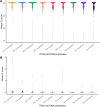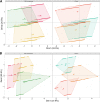Amplicon-Based High-Throughput Sequencing Method for Genotypic Characterization of Norovirus in Oysters
- PMID: 37071010
- PMCID: PMC10231197
- DOI: 10.1128/aem.02165-22
Amplicon-Based High-Throughput Sequencing Method for Genotypic Characterization of Norovirus in Oysters
Abstract
Norovirus is a highly diverse RNA virus often implicated in foodborne outbreaks, particularly those associated with shellfish. Shellfish are filter feeders, and when harvested in bays exposed to wastewater overflow or storm overflows, they can harbor various pathogens, including human-pathogenic viruses. The application of Sanger or amplicon-based high-throughput sequencing (HTS) technologies to identify human pathogens in shellfish faces two main challenges: (i) distinguishing multiple genotypes/variants in a single sample and (ii) low concentrations of norovirus RNA. Here, we assessed the performance of a novel norovirus capsid amplicon HTS method. We generated a panel of spiked oysters containing various norovirus concentrations with different genotypic compositions. Several DNA polymerases and reverse transcriptases (RTs) were compared, and performance was evaluated based on (i) the number of reads passing quality filters per sample, (ii) the number of correct genotypes identified, and (iii) the sequence identity of outputs compared to Sanger-derived sequences. A combination of the reverse transcriptase LunaScript and the DNA polymerase AmpliTaq Gold provided the best results. The method was then employed, and compared with Sanger sequencing, to characterize norovirus populations in naturally contaminated oysters. IMPORTANCE While foodborne outbreaks account for approximately 14% of norovirus cases (L. Verhoef, J. Hewitt, L. Barclay, S. Ahmed, R. Lake, A. J. Hall, B. Lopman, A. Kroneman, H. Vennema, J. Vinjé, and M. Koopmans, Emerg Infect Dis 21:592-599, 2015), we do not have standardized high-throughput sequencing methods for genotypic characterization in foodstuffs. Here, we present an optimized amplicon high-throughput sequencing method for the genotypic characterization of norovirus in oysters. This method can accurately detect and characterize norovirus at concentrations found in oysters grown in production areas impacted by human wastewater discharges. It will permit the investigation of norovirus genetic diversity in complex matrices and contribute to ongoing surveillance of norovirus in the environment.
Keywords: Caliciviridae; DNA polymerase; DNA sequencing; Illumina; calicivirus; environmental microbiology; environmental virology; food safety; reverse transcriptase; virology.
Conflict of interest statement
The authors declare no conflict of interest.
Figures



Similar articles
-
Characterisation of norovirus contamination in an Irish shellfishery using real-time RT-qPCR and sequencing analysis.Int J Food Microbiol. 2012 Nov 15;160(2):105-12. doi: 10.1016/j.ijfoodmicro.2012.10.001. Epub 2012 Oct 16. Int J Food Microbiol. 2012. PMID: 23177049
-
Metagenomic to evaluate norovirus genomic diversity in oysters: Impact on hexamer selection and targeted capture-based enrichment.Int J Food Microbiol. 2020 Jun 16;323:108588. doi: 10.1016/j.ijfoodmicro.2020.108588. Epub 2020 Mar 12. Int J Food Microbiol. 2020. PMID: 32200157
-
Digital PCR for Quantifying Norovirus in Oysters Implicated in Outbreaks, France.Emerg Infect Dis. 2016 Dec;22(12):2189-2191. doi: 10.3201/eid2212.160841. Emerg Infect Dis. 2016. PMID: 27869597 Free PMC article.
-
Current decontamination challenges and potentially complementary solutions to safeguard the vulnerable seafood industry from recalcitrant human norovirus in live shellfish: Quo Vadis?Sci Total Environ. 2023 May 20;874:162380. doi: 10.1016/j.scitotenv.2023.162380. Epub 2023 Feb 24. Sci Total Environ. 2023. PMID: 36841407 Review.
-
Progress and challenges in thermal inactivation of norovirus in oysters.Crit Rev Food Sci Nutr. 2025 Feb 25:1-14. doi: 10.1080/10408398.2025.2467209. Online ahead of print. Crit Rev Food Sci Nutr. 2025. PMID: 40007190 Review.
Cited by
-
Complete Genomic Characterization of Global Pathogens, Respiratory Syncytial Virus (RSV), and Human Norovirus (HuNoV) Using Probe-based Capture Enrichment.bioRxiv [Preprint]. 2024 Sep 16:2024.09.16.613242. doi: 10.1101/2024.09.16.613242. bioRxiv. 2024. Update in: Sci Rep. 2025 Jul 1;15(1):20526. doi: 10.1038/s41598-025-03398-6. PMID: 39345650 Free PMC article. Updated. Preprint.
-
Complete genomic characterization of global pathogens respiratory syntical virus and human norovirus using probe based capture enrichment.Sci Rep. 2025 Jul 1;15(1):20526. doi: 10.1038/s41598-025-03398-6. Sci Rep. 2025. PMID: 40594045 Free PMC article.
-
High-performance enrichment-based genome sequencing to support the investigation of hepatitis A virus outbreaks.Microbiol Spectr. 2024 Jan 11;12(1):e0283423. doi: 10.1128/spectrum.02834-23. Epub 2023 Nov 29. Microbiol Spectr. 2024. PMID: 38018979 Free PMC article.
References
-
- Rajko-Nenow P, Waters A, Keaveney S, Flannery J, Tuite G, Coughlan S, O’Flaherty V, Doré W. 2013. Norovirus genotypes present in oysters and in effluent from a wastewater treatment plant during the seasonal peak of infections in Ireland in 2010. Appl Environ Microbiol 79:2578–2587. doi:10.1128/AEM.03557-12. - DOI - PMC - PubMed
-
- Suffredini E, Iaconelli M, Equestre M, Valdazo-González B, Ciccaglione AR, Marcantonio C, Della LS, Bignami F, La Rosa G. 2017. Genetic diversity among genogroup II noroviruses and progressive emergence of GII.17 in wastewaters in Italy (2011–2016) revealed by next-generation and Sanger sequencing. Food Environ Virol 10:141–150. doi:10.1007/s12560-017-9328-y. - DOI - PubMed
Publication types
MeSH terms
Substances
LinkOut - more resources
Full Text Sources
Medical

